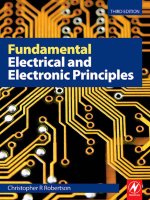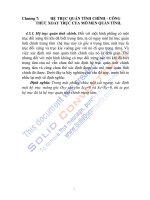Bài giảng Electrical and electronic principles: Chương 7 - ThS. Ngô Quốc Cường
Bạn đang xem bản rút gọn của tài liệu. Xem và tải ngay bản đầy đủ của tài liệu tại đây (691.62 KB, 23 trang )
TRƯỜNG ĐẠI HỌC SƯ PHẠM KỸ THUẬT
TP. HỒ CHÍ MINH
ELECTRICAL AND ELECTRONIC
PRINCIPLES
WEEK 7, 8
Cuong Q. Ngo
Last classes
• Trigonometric Fourier series
• Plot function - MATLAB
• Circuit Application (Applying Fourier series)
2
Contents (Today class)
• Laplace transform
• Circuit element models
• Circuit analysis
• Transient analysis
3
1. Laplace Transform
• The Laplace transform is an integral transformation of a
function f (t) from the time domain into the complex frequency
domain, giving F (s).
• Where s is a complex variable: 𝑠 = 𝜎 + 𝑗𝜔
4
1. Laplace Transform
• Determine the Laplace transform of
5
1. Laplace Transform
• Laplace transform
pairs (f(t) = 0, for t < 0)
6
1. Laplace Transform
• Laplace transform
pairs (f(t) = 0, for t < 0)
7
1. Laplace Transform
• Inverse Laplace transform
1. Decompose F(s) into simple terms using partial fraction
expansion.
2. Find the inverse of each term by matching entries in the
previous table.
8
1. Laplace Transform
• Find the inverse Laplace transform of
9
1. Laplace Transform
• Answer:
𝑓 𝑡 = 3𝑢 𝑡 − 5𝑒 −𝑡 𝑢 𝑡 + 3 sin 2𝑡 𝑢(𝑡)
10
1. Laplace Transform
• Find f(t) given that
11
1. Laplace Transform
• Answer:
𝑓 𝑡 = (2 − 8𝑒 −2𝑡 + 7𝑒 −3𝑡 )𝑢(𝑡)
12
2. Circuit element models
• For a resistor
13
2. Circuit element models
• Representation of an inductor:
14
2. Circuit element models
• Representation of a capacitor:
15
2. Circuit element models
• Impedance of elements in the s-domain (zero initial condition)
16
3. Circuit analysis
• Steps in applying the Laplace transform
1. Transform the circuit from the time domain to the s-domain.
2. Solve the circuit using nodal analysis, mesh analysis,
sourcetransformation, superposition, or any circuit analysis
techniquewith which we are familiar.
3. Take the inverse transform of the solution and thus obtain
thesolution in the time domain.
17
3. Circuit analysis
• Find vo(t) in the circuit, assuming zero intial condition
18
3. Circuit analysis
• Answer:
19
3. Circuit analysis
• The switch closes the circuit at t = 0. Find i(t) for t > 0
i(t)
20
3. Circuit analysis
• Answer:
𝑅
𝑉
−𝑡 𝐿
𝑖 𝑡 =
1−𝑒
𝑅
21
4. Trasient analysis (MultiSim)
• Multisim computes the circuit’s response as a function of
time.
• Each input cycle is divided into intervals, and a DC analysis
is performed for each time point in the cycle.
22
4. Transient analysis
23









